Today’s dish, Ocean Perch with Thickened Vegetable Sauce is a unique way of eating pan-fried fish. At first glance, it looks like a pile of cooked vegetables. But the pan-fried ocean perch fillet that’s underneath it goes so well with the Thickened Vegetable Sauce.
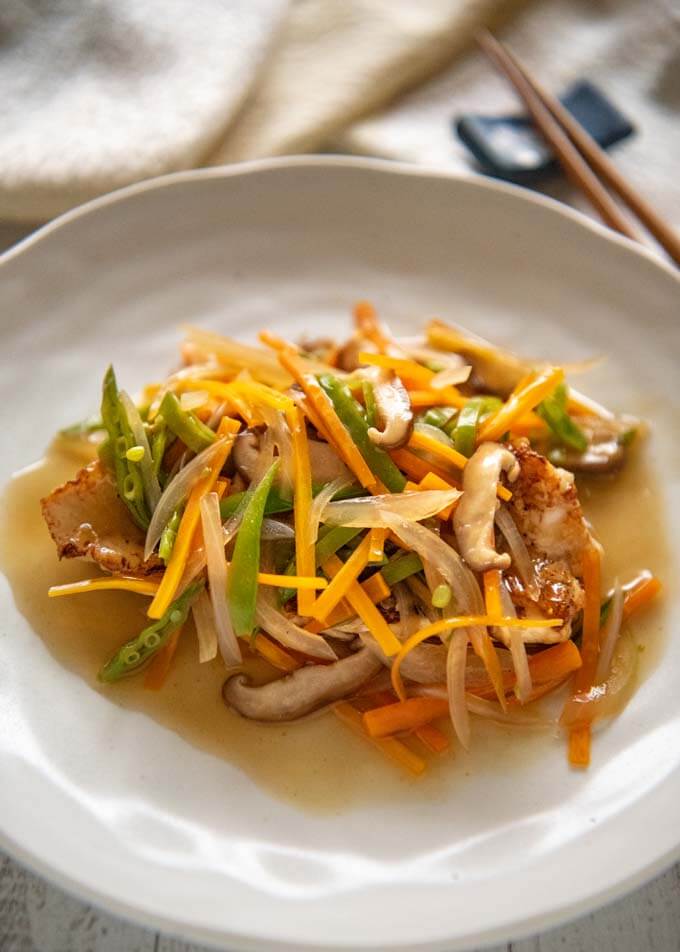
Unlike Western-style pan-fried fish, which is often served with a creamy sauce or a buttery sauce, today’s fish is served with ‘vegetable Ankake’ – Thickened Vegetable Sauce.
About Ankake
Ankake (餡掛け) is a generic term for a flavoured sauce that is thickened by adding cornflour/corn starch or any other kind of starch.
The flavour of the sauce can be almost anything. But the most traditional Ankake flavours are a simple dashi-based soy flavour or the sweet vinegar flavour that I used in the post Japanese Pork Meatball (Niku-dango).
The colour of Ankake can also vary from almost transparent to dark soy colour. The sauce can contain vegetables and/or meat (see my Tofu with Vegetable Sauce), or nothing, i.e. just a plain thick sauce as you can see in my Japanese Pork Meatball (Niku-dango) dishes.
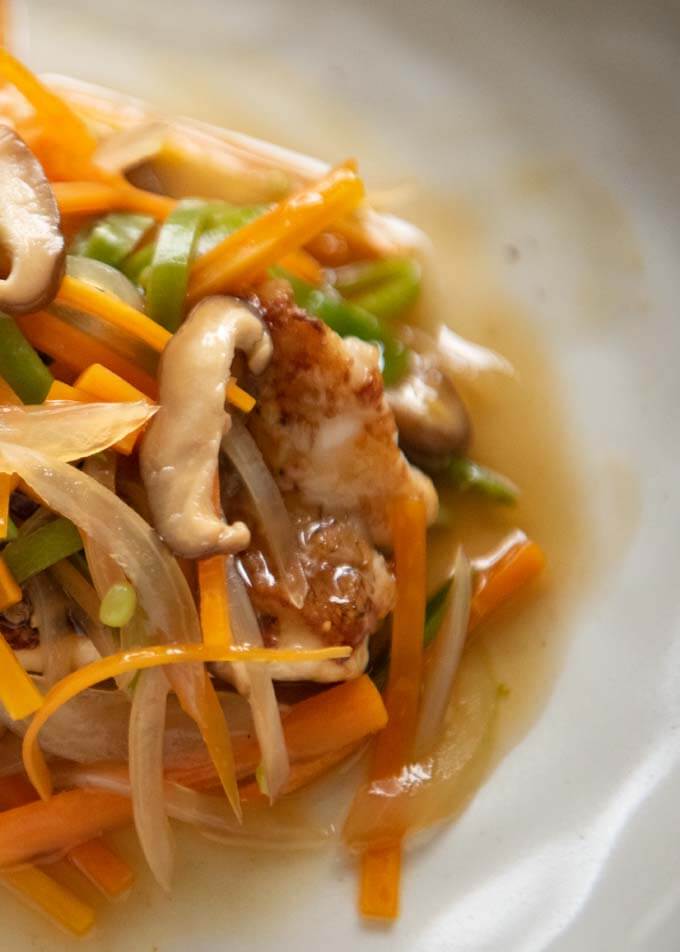
The different types of Ankake are named by adding a word that represents the flavour and/or the ingredients of the sauce. Today’s Ankake is a vegetables sauce so it is called ‘yasai ankake’ (野菜餡掛け). The word ‘yasai’ (野菜) means vegetables. The sweet vinegar Ankake is called ‘amazu ankake’ (甘酢餡掛け). ‘Amazu’ means sweet vinegar.
How to Use Ankake
Ankake is a sauce to be poured over the main cooked ingredient. The main ingredient can be fish, chicken, tofu, fried noodles, rice or noodle soup. I haven’t seen red meat with Ankake.
To enjoy the flavour of the Ankake, the fish and chicken are usually cooked in the simplest manner – steamed, poached or pan-fried.
Ankake not only makes the sauce cling onto the main ingredient but also keeps the dish warm for a long time.
When Ankake is poured over udon or soba noodle soup, it keeps the noodle soup hot for a very long time. It is great to have noodles like this on a very cold day. Incidentally, these noodle soups are called ‘ankake udon’ (餡掛けうどん) or ‘ankake soba’ (餡掛けそば) respectively.
How to Make Thickened Vegetable Sauce
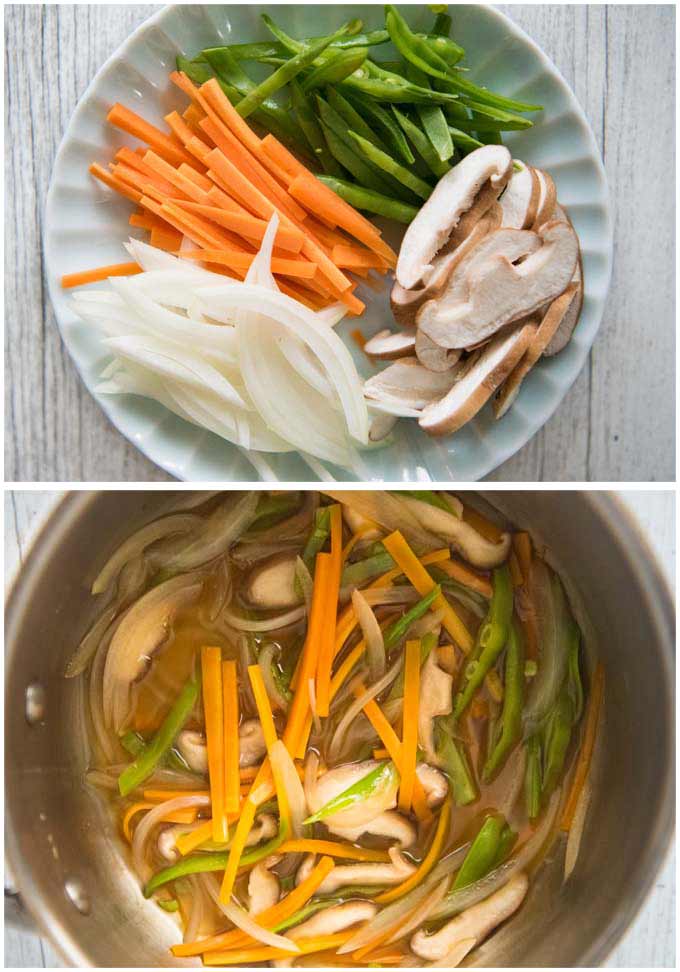
The Thickened Vegetable Sauce (Vegetable Ankake) is made by simply adding cornflour/corn starch to the flavoured sauce with cooked vegetables. But the cornflour/corn starch needs to be added at the very end.
My Thickened Vegetable Sauce consists of onion, carrot, shiitake mushrooms and snow peas. They are cut into strips of similar length.
Cook them in a dashi stock for a few minutes, before adding flavouring, then add cornflour to thicken the sauce. To prevent discolouration and overcooking, I add snow peas at the end.
The flavouring of the sauce is a combination of light soy sauce, sake, mirin and salt.
Variations to Ocean Perch with Thickened Vegetable Sauce
The fish does not have to be ocean perch. It can be any non-oily white/whitish flesh fish. It can also be a piece of fish with bones in it or a small whole fish. I once made pan-fried yellow tail with Vegetable Ankake and it was delicious.
Just a little note for cooking a fish: Fish fillets and even a whole fish can vary in thickness. Usually the middle of the fish is thicker than both ends. To cook the fish evenly, score the fish on the skin side where the flesh is thick (see the photo below).
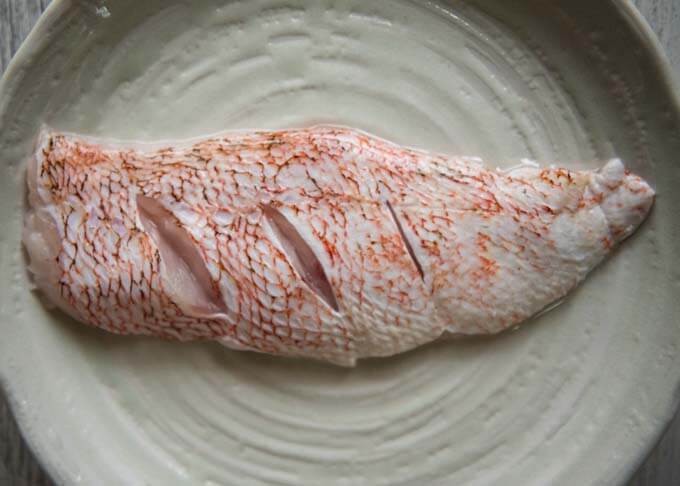
Instead of pan-frying, you can poach or even deep fry. If deep frying, lightly flour the fish before frying.
You can substitute the vegetables that I used with other vegetables such as shallots/scallions, bamboo shoots, other Asian mushrooms, beans, cabbage, zucchini, etc.
You could make a plain sauce by not adding vegetables at all, but I think that you want to have at least a couple of vegetables.
I cut all the vegetables into thin strips, but you can dice the vegetables instead.
My sauce is quite pale so that you can see the original colours of the vegetables. But you can make it a bit darker. Instead of using light soy sauce, you can use normal soy source (like Kikkoman soy sauce that you can buy at the supermarket) or increase the quantity of soy sauce and omit the salt.
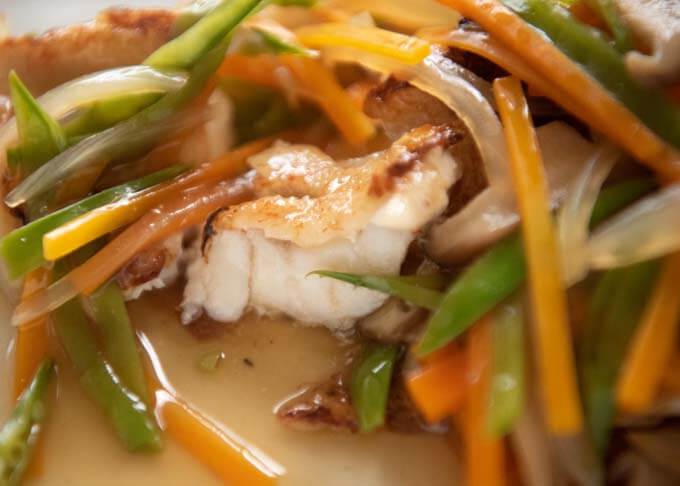
Ocean Perch with Thickened Vegetable Sauce (Vegetable Ankake) is one of those dishes that looks complicated but actually very easy to make and the variations are limitless. I hope you try it.
Yumiko![]()

Pan-fried ocean perch fillet is covered with a thick vegetable sauce and has a savoury flavour. It might look complicated, but it is quite easy to make. The ocean perch goes so well with the Thickened Vegetable Sauce.
Don't forget to see the section 'MEAL IDEAS' below the recipe card! It gives you a list of dishes that I have already posted and this recipe that can make up a complete meal. I hope it is of help to you.
- 1 ocean perch fillet (note1)
- a large pinch of salt
- ½ tbsp oil
- 40g/1.4oz onion , thinly sliced
- 25g/0.9oz carrot , cut into 5cm long thin matchsticks
- 2 shiitake mushrooms , thinly sliced (about 15g/0.5oz)
- 15g/0.5oz snow peas , diagonally sliced
- 120ml/4.1oz dashi stock
- 2 tsp mirin
- 1 tsp soy sauce
- 2 tsp cooking sake
- ¼ tsp salt
- 1½ tsp cornflour/corn starch diluted in 2 tsp water
-
On the skin side of the fillet, score diagonally in a few places where the flesh is thick. This will allow the fillet to cook evenly.
-
Sprinkle salt on both sides of the fillet.
-
Heat a frypan with oil over medium heat.
-
Put the fillet skin side down. Press down the fillet for a while to prevent it from curling.
-
Cook for 3 minutes, turn it over and cook for about 3 minutes until the flesh is just cooked and no longer translucent (note 2).
-
Transfer the fish to a serving plate, skin side up.
-
Pour the Vegetable Sauce over the fish. Serve immediately.
-
Add dashi stock and all the vegetables, excluding snow peas, to a saucepan and bring it to a boil. Cook for a couple of minutes.
-
Add the snow peas and the remaining Sauce ingredients except cornflour/corn starch to the pan.
-
When it starts boiling again, add the cornflour/corn starch in a swirling motion and quickly mix the sauce. The sauce should thicken.
-
As soon as it starts boiling, turn the heat off.
1. My ocean perch fillet was about 135g/4.8oz and no thicker than 2.5cm/1” but you can make it a bit larger if you want.
This recipe will work with any non-oily white flesh fish fillet such as snapper, barramundi, or cod.
2. If your fish is larger and thicker than mine, it will take a bit longer to cook.
3. Nutrition per serving.
serving: 385g calories: 329kcal fat: 9.9g (15%) saturated fat: 1.1g (6%) trans fat: 0.1g polyunsaturated fat: 2.1g monounsaturated fat: 5.6g cholesterol: 58mg (19%) sodium: 1317mg (55%) potassium: 887mg (25%) carbohydrates: 16g (5%) dietary fibre: 2.5g (10%) sugar: 8.2g protein: 38g vitamin a: 88% vitamin c: 26% calcium: 13% iron: 13%
Meal Ideas
A typical Japanese meal consists of a main dish, a couple of side dishes, a soup and rice. I try to come up with a combination of dishes with a variety of flavours, colours, textures and make-ahead dishes.
Today’s main dish is quite light, so I can afford to add a side dish with a rich flavouring or a slightly oily dish to go with it. Deep Fried Lotus Root and Prawn Sandwiches gives not only a bit of volume to the meal but also a totally different texture.
The main dish has lots of colourful vegetables in the sauce and I don’t need to think about adding more colours to the meal. So I decided to focus on adding different flavours by choosing Pickled Celery in Fish Sauce.
- Main: Ocean Perch with Thickened Vegetable Sauce (Ankake) – today’s dish
- Side dish 1: Deep Fried Lotus Root and Prawn Sandwiches – can be made ahead
- Side dish 2: Pickled Celery in Fish Sauce – make ahead
- Soup: Miso Soup of your choice from Miso Soup Ingredient Combinations or your favourite ingredients
- Rice: Cooked Rice
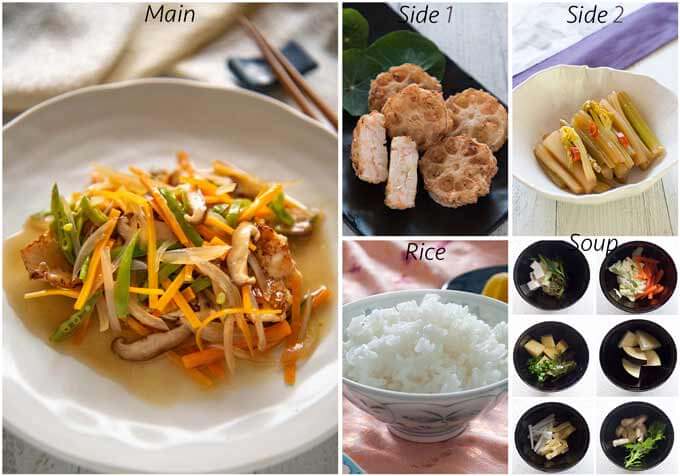
Made this with defrosted haddock filets and it was fantastic! Light, clean flavors and a beautiful presentation! Thank you! 😄